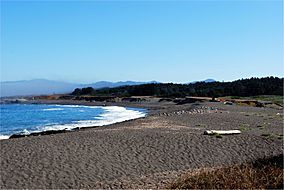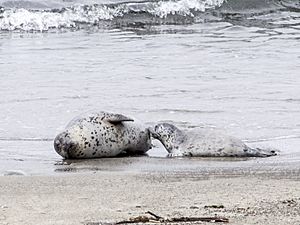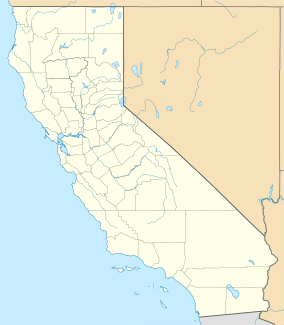MacKerricher State Park facts for kids
Quick facts for kids MacKerricher State Park |
|
|---|---|
 |
|
| Location | Mendocino County, California |
| Nearest city | Fort Bragg, California |
| Area | 2,299 acres (930 ha) |
| Established | 1952 |
| Governing body | California Department of Parks and Recreation |

MacKerricher State Park is a beautiful state park in California, United States. It is located about 3 miles north of Fort Bragg in Mendocino County. This park stretches along 9 miles of coastline and has many different natural areas. These include sandy beaches, rolling dunes, rocky headlands, hidden coves, marshy wetlands, and amazing tide pools. It also has forests and a freshwater lake!
Contents
Exploring MacKerricher's Landscapes
MacKerricher State Park offers many different types of scenery. The northern part of the park has a long, gently sloping beach. As you move south, you'll find rocky cliffs and flat areas with smaller strips of sand.
Inland from the ocean, there is a special place called Lake Cleone. This lake used to be a salty marsh, but a road was built that closed it off. Now, it's a 30-acre freshwater lake.
A large part of the northern park is home to the Inglenook Fen Ten Mile Dunes Preserve. This area has sensitive sand dunes with both wet and dry plant zones. Laguna Point is a peninsula that sticks out into the ocean near the middle of the park. The Ten Mile River forms the park's northern border, and several smaller creeks flow through the land into the Pacific Ocean.
Amazing Animals and Plants
MacKerricher State Park is full of interesting wildlife and plants. The rocky headlands are covered in green grasses and colorful wildflowers. Just a bit further inland, you'll find wooded areas with bishop pine trees, shore pines, and Douglas firs.
Rare Plants
The park is very important for a rare plant called the Mendocino spineflower. About 95% of all these flowers in the world grow right here in the protected dunes of the Inglenook Preserve!
Wildlife Watching
You can often spot harbor seals resting on the rocks, enjoying the sun. If you visit between December and April, you might even see Gray whales migrating along the coast. This is a great chance for whale watching!
Other animals living in the park include black-tailed deer, raccoons, and gray foxes. Sometimes, you might even see a mountain lion. The tide pools are bursting with life, showing off many different sea creatures.
More than 90 types of birds live in or visit the park. These include birds that migrate for the winter and those that live here all year, like ospreys, great blue herons, ring-necked ducks, and mallards.
Endangered Fish
An endangered species of fish called the tidewater goby lives in the local creeks and rivers. Some of these waterways have recently been marked as important areas for this fish. The park might even grow bigger to help protect them!
A Glimpse into MacKerricher's Past
Long ago, Indigenous peoples of California like the Pomo and Yuki peoples lived in or traveled through this area. They gathered food like seaweed, shellfish, and acorns. The Mendocino Indian Reservation was also set up in this region.
Later, in 1864, a Canadian family named Duncan and Jessie MacKerricher moved here. They started a ranch and hired local native people to help them. Their ranch produced butter, potatoes, and draft horses. In 1949, the MacKerricher family's descendants sold their land to the state of California. That's how it became the state park we know today!
Fun Things to Do in the Park
MacKerricher State Park offers many fun activities for visitors. Park staff often lead guided hikes and special whale watching trips. There are also campgrounds and other facilities for people to use.
You can go fishing in Lake Cleone. The park has many trails perfect for walking, cycling, and even horseback riding.
Discovering Glass Beach
At the southern end of the park, you'll find the famous Glass Beach. This beach is unique because it's covered in smooth, colorful glass pebbles! These glass pieces are leftovers from when the beach was used as a dump in the 1950s and 60s. Over many years, the ocean's waves and tides have tumbled the broken glass, turning it into beautiful, polished "trinkets" that people love to find.



